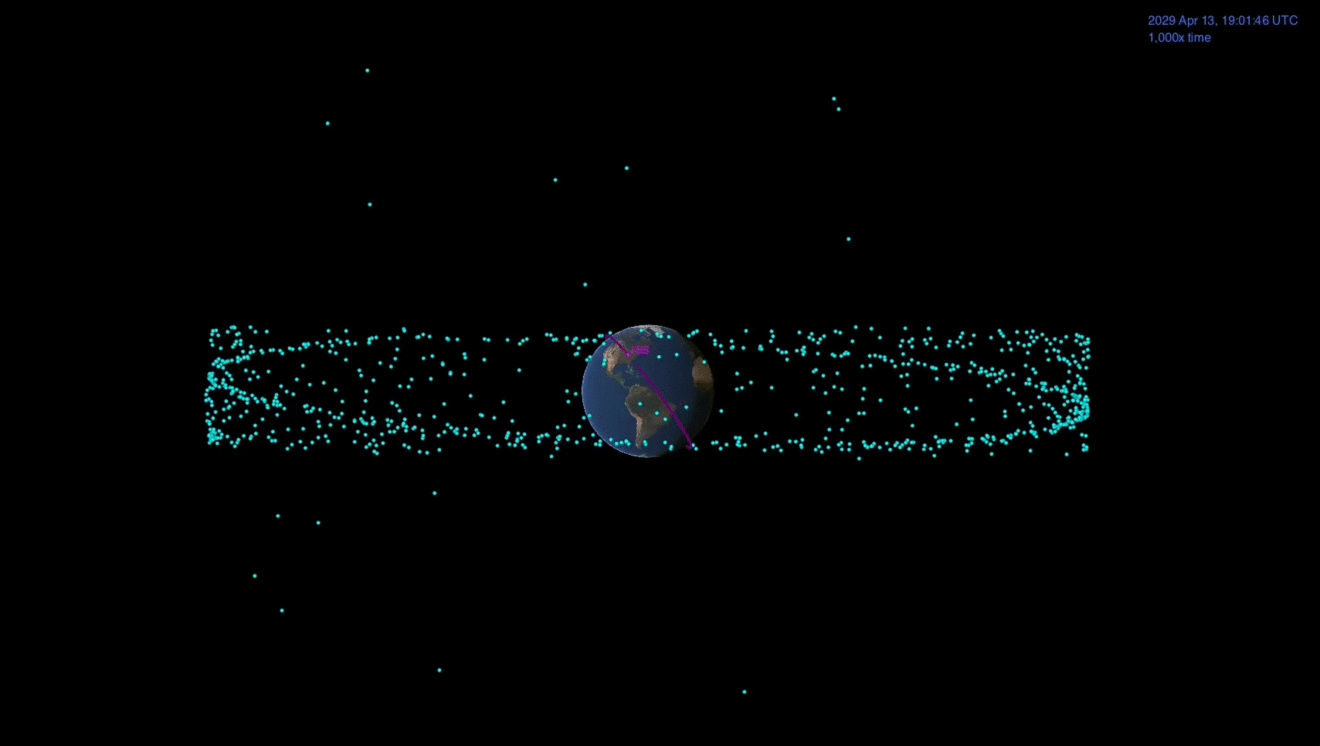
The asteroid Apophis, infamous because it's headed to brush past Earth in 2029, most likely isn't something to worry about, a new study finds. This space rock, scientists calculated, will not collide with other space rocks that could worryingly alter its orbit and redirect it toward Earth — at least until the day it swings past our planet, that is.
Apophis is a peanut-shaped, near-Earth asteroid leftover from the formation of our solar system about 4.6 billion years ago. It wobbles back and forth even while spinning on its axis and rotating once every 30 hours. On April 13, 2029, the space rock is scheduled to approach Earth, coming within 20,000 miles (32,000 kilometers) of our planet's surface. The event will mark the closest Earth flyby of an asteroid of this size that scientists managed to forewarn. It's also when NASA's OSIRIS-APEX spacecraft, formerly named OSIRIS-REx, is scheduled to encounter Apophis.
Related: Apophis: The infamous asteroid we thought might hit us
While the 1,000-foot-wide (305-meter-wide) asteroid isn't following a trajectory that'll lead it to impact our planet — scientists have confidently ruled out any such impact for the next 100 years — it was unclear until now just how much its path could change, if at all, due to collisions with other space rocks. A new analysis that computed the paths of all 1.2 million asteroids and comets known to reside in our solar system pegs that risk to zero.
"Fortunately, no such collisions are anticipated," study lead author Paul Wiegert, an astronomer at the University of Western Ontario in Canada, said in a statement. "Even now that we know it's on course to miss us by a safe margin, astronomers remain vigilant. It's the asteroid we just can't stop watching."
Wiegert and his colleague Ben Hyatt of University of Waterloo in Canada describe the new analysis in a preprint paper accepted for publication in the Planetary Science Journal.
To arrive at their conclusions, Wiegert and Hyatt analyzed two independent databases that cataloged the orbits of asteroids and comets in our solar system — one maintained by NASA's Jet Propulsion Laboratory (JPL) and the other by the European Space Agency (ESA). After winnowing down the list of asteroids and comets whose orbits come within 0.001 AU of Apophis, the researchers came up with 376 objects from the JPL catalog and 396 from ESA's; over 300 of these objects appeared in both databases.
Simulations of the chosen orbits showed that none of the studied asteroids or comets will directly hit Apophis before its April 2029 fly past Earth, meaning its orbit is unlikely to be redirected toward our planet.
Wiegert and Hyatt also found Apophis will pass a little over 310,000 miles (500,000 km) of another asteroid named 4544 Xanthus in December 2026. While both space rocks will not collide — 4544 Xanthus will pass the duo's intersection point just four hours after Apophis. "The encounter is close enough that material accompanying Xanthus (if any) could strike Apophis," according to the new study. "This could result in a perturbation of its future path that could affect its impact probability with Earth."
However, precisely how that material would alter Apophis' orbit, if at all, remains unclear.
Wiegert and Hyatt posit that any loose dust particles ejected from 1.3 km-long Xanthus could strike Apophis, although only future observations could confirm or deny the presence of material in its orbit. While millimeter-sized particles wouldn't have a substantial effect on Apophis' orbit, even a single centimeter-sized particle, like bits seen on Bennu, traveling at a speed of 11 kilometers per second could release energy "equivalent to 20 sticks of dynamite," according to the new study. But future optical observation campaigns, for instance, may reveal whether Xanthus has any material in its orbit to begin with.







